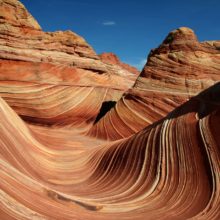The Department of Interior is evaluating whether to restore national monuments that were shrunk by the Trump Administration. These are the Bears Ears National Monument, which was reduced by 85%, and the Grand-Staircase Escalante National Monument, reduced by almost half.
As tourism pressure mounts, the protections under national monument status ensure cultural and natural resources at the sites are protected. However, the protections may limit some kinds of economic activity, such as mining. How do these protections affect the local economies?
Recent studies have evaluated the role of national monument designation on local economies. The research concludes that national monument designations do not negatively impact local economic performance, and in many cases the designations improve local economies. Each of the studies is summarized below. Two studies are also summarized in this joint article by economists at Utah State University and Resources for the Future.
Headwaters Economics Analysis
In 2017, Headwaters Economics analyzed the long-term trends in four economic indicators (growth in population, employment, real personal income, and real per capita income) in the years before and after the designation of 17 national monuments of 10,000 acres or more in size. County-level data was derived from the Bureau of Economic Analysis of the U.S. Department of Commerce.
The results show that in all cases, the growth trajectory of the local economy at the time the monument was designated simply continued after designation. In all cases, if there was economic growth, the growth was not altered after designation.
The authors are clear to point out that the results of this analysis do not prove or disprove a cause-and-effect relationship. However, the results of the study do make it difficult to claim, as some have done, that national monument designation has a detrimental effect on the economy because performance indicators for the 17 monuments investigated show economic growth following designation. The only exception was in eastern Montana where population has been declining for decades, even though in this region personal income rose after monument designation.
Utah State University Analysis
Paul Jakus and Sherzod Akhundjanov of Utah State University conducted two nearly identical studies in 2018 and 2019 evaluating the effect on per capita income of designating national monuments. The first evaluated the impact of designating Grand Staircase-Escalante National Monument and the second evaluated eight other national monuments 50,000 acres or larger.
The authors used statistical methods to compare the change in per capita income between counties with national monuments to socioeconomically and geographically similar counties without monuments. By looking at per capita income before and after monuments were designated, the authors were able to identify whether changes in per capita income can be attributed to designation, or whether they were due to other factors.
Jakus and Akhundjanov found that per capita income neither grew nor shrank in response to monument designation.
Resources for the Future Analysis
The most recent study, published in 2020 by Margaret Walls, Patrick Lee, and Matthew Ashenfarb of Resources for the Future, used a methodological approach similar to Utah State University, but instead used business establishments and growth in jobs to measure economic well-being. Their data is from the National Establishment Time-Series (NETS) database, a highly detailed, proprietary dataset containing zip code-level data regarding the sources of business and job creation.
Looking at zip codes immediately adjacent to 14 national monuments established between 1991 and 2014, they found that monument designation is associated with 10% more business establishments and 8.5% more jobs in the years following designation. Most job increases are in hotels, business services, health services, construction, and finance, investments, and real estate. They found a positive growth rate of 0.92% in businesses being established, most of which comes from fewer establishments closing. From this, the researchers conclude that “monument designations appear to increase the staying power of new businesses.”
Southern Utah University Analysis
An additional study by Ryan Yonk, Randy Simmons, and Brian Steed in 2013 found a negative relationship between monument designation and one economic measure (non-farm payroll), but the unclear methods make the findings unreliable. As was done with the Utah State University and Resources for the Future studies, this study compared a group of counties with national monuments nearby to a control group of counties without national monuments. Unlike the other studies, however, Yonk et. al. do not identify which counties are in the control group nor the selection criteria used to find suitable control counties. As a result, their findings may be attributable to geographic or socioeconomic differences between the control and treatment counties, not monument designation.
Summary
Studies using statistical methods to evaluate the economic impact on local economies of designating a national monument find either a positive effect on economic well-being (Walls et al., 2020; Rasker et al., 2013), or no effect (Jakus & Akhundjanov, 2018 & 2019). One study finds a negative relationship between monument designation and one economic measure (Yonk et al., 2013), but the unclear methods make the findings unreliable.
The body of peer-reviewed literature suggests that counties with extensive protected federal land attract higher per capita income and wealth. Designation itself has little effect on per capita income but does appear to spur business and job growth and reduce the rate of business closures in the years following monument designation.
It is important to note that these analyses considered only a handful of economic performance metrics and did not consider the cultural and intrinsic values of preserving cultural resources, antiquities, or environmental quality. The analyses also do not consider directly the opportunity cost of natural resources not extracted due to new land management requirements. As Secretary Haaland reviews the boundaries for Bears Ears and Grand Staircase Escalante National Monuments the weight of the economic arguments for and against the monuments ought to be one element she considers. The best research tells us that national monument designation has little effect on per capita income in a community, yet monuments do appear to contribute to the establishment of new businesses and staying power of existing ones.
References
Headwaters Economics. (2017). The economic importance of national monuments to communities.
Jakus PM & Akhundjanov SB. (2018). Neither boon nor bane: the economic effects of a landscape-scale national monument. Land Economics 94(3), 323-339.
Jakus PM & Akhundjanov SB. (2019). The Antiquities Act, national monuments, and the regional economy. Journal of Environmental Economics and Management 95, 102-117.
Rasker R, Gude PH, & Delorey M. (2013). The effect of protected federal lands on economic prosperity in the non-metropolitan West. Journal of Regional Analysis & Policy 43(2), 110-122.
Walls M, Lee P, & Ashenfarb M. (2020). National monuments and economic growth in the American West. Science Advances 6(12), eaay8523.
Yonk RM, Simmons RT, & Steed BC. (2013). Politics, economics, and federal land designation: Assessing the economic impact of land protection—Grand Staircase-Escalante National Monument. Mountain Plains Journal of Business and Technology 14(1), 2.





